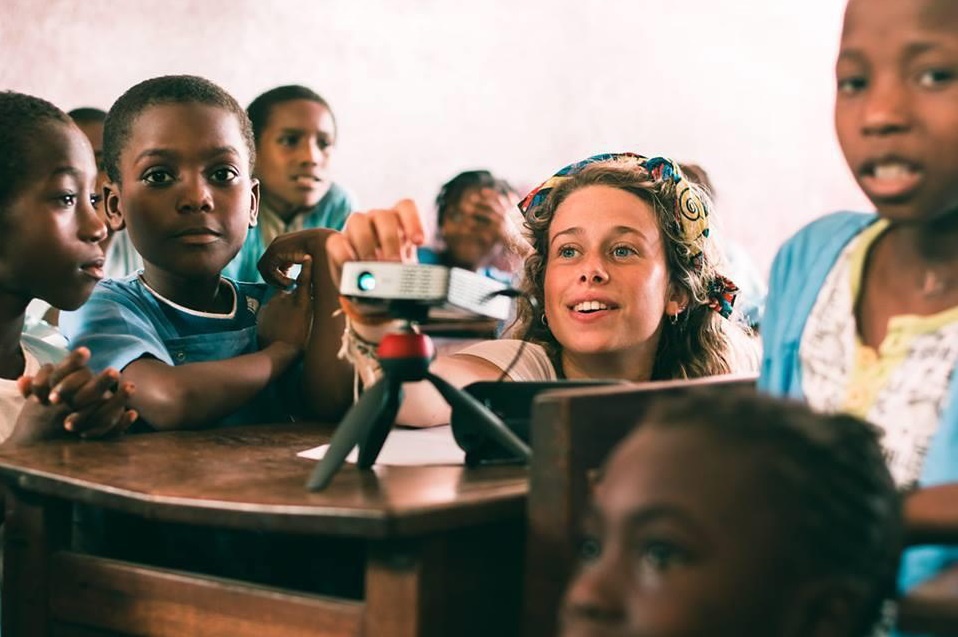
New PhD - Martina Panisi- Snails, forest and people: conservation and ecology of terrestrial molluscs in a tropical island
São Tomé Island, in Central Africa, holds a rich diversity of endemic land snail species. Very little is known about their ecology, making it hard to establish conservation priorities. Martina’s PhD will explore the relationship between terrestrial snails, the forest and people in São Tomé. She will focus on aspects such as the distribution, habitat associations, breeding and feeding ecology, main threats, socio-economic importance and human perceptions of snail, integrating ecological and social approaches. With a final goal to provide a better understanding of the malacological fauna of the island and its links to ecosystems and people.
The Forest Giants Project
The aim of this project is to promote the importance of conservation of native biodiversity and the role of each person for its safeguard, using the story of the native threatened giant Obô Snail (Archachatina bicarinata) in São Tomé Island, West Africa. The Obô Snail is one of countless species suffering a rapid decline due to habitat destruction, overharvesting and introduction of invasive species. Engaging people in biodiversity conservation is critical for its effectiveness, and the project is using this species to represent the unique biodiversity of São Tomé island's native forest. The project over the next 15 months the project aims engaging local people through environmental education activities and scientific research and international people through storytelling on social media and ecotourism. It will give classes and workshops in local communities and schools living in
the surroundings of the protected Obô Natural Park. Use storytelling together with social media to reach a broader audience. They will perform surveys in the forest to study the species distribution and abundance. Also build a conservation centre for the Obô Snail that will serve to, reproduce the species, study its ecology, as a didactic centre and provide ecotourism services. Project has already been running for a few months and has already reached hundreds of people across the island and engaged them on the snail. The project team includes, Gabriel Oquiongo - Field Assistant Monte Pico NGO, Martina Panisi -Conservation Biologist and Vasco Pissarra - Ecologist.
New findings of phytophagous insects on the Ilhéu Chão (Desertas Islands, Madeira Archipelago)
Research that was carried out by three members of this group has provided new taxonomic findings of aphids (Aphidoidea) and scales (Coccoidea) for Ilhéu Chão (Desertas Islands, Madeira Archipelago). They also provided information on the host plant associations of these phytophagous insects. The paper highlighted the need for further research on the insect fauna of Desertas Islands. The research established a number of new records, including Protaphis pseudocardui (Theobald, 1915) was recorded for the first time reported to Madeira archipelago, while the aphids Aphis craccivora, A. gossypii, A. umbrella and Uroleucon sonchi, and the scales Coccus cf. hesperidum, Icerya purchasi, Pulvinaria urbicola, Saissetia coffeae and S. oleae are new findings to the Desertas Islands. For the full paper authored by: Cândida Ramos, A. M. Franquinho Aguiar, Isamberto Silva, Ana Mourão, Renata santos, Carla Rego & Mário Boieiro, see the link below: https://www.researchgate.net/publication/330902002_New_findings_of_phytophagous_insects_Hemiptera_Coccoidea_and_Aphidoidea_from_Ilheu_Chao_Desertas_Islands_Madeira_Archipelago
The butterfly fauna of Porto Santo
Porto Santo (Madeira Archipelago) is an ancient and small volcanic island. The main part of the island is characterised by semiarid climate and xeric vegetation, while the higher altitudes show subhumid conditions. Eleven butterfly species have been recorded on Porto Santo, including the first publication of Macroglossum stellatarum (Sphingidae). The distribution of butterfly species on Porto Santo was studied during March 2017. Three species (Colias croceus, Pieris rapae and Vanessa cardui) show a wide occurrence on Porto Santo. As an exception, Vanessa vulcania could be found only within one grid of subhumid habitat in the north of the island, at an altitude of 235 m a.s.l. Vanessa vulcania is probably a remnant of an earlier time period, where – due to lack of human impact – larger areas with microforests and in part Apollonias barbujana laurisilva existed. Leptotes pirithous, Macroglossum stellatarum, Pararge aegeria (which all newly colonised Porto Santo), and the migratory Danaus plexippus show a scattered distribution. The butterfly-plant network was sampled with 115 butterfly-plant interactions could be recorded. The network shows more plant than butterfly species and is asymmetric: Seven butterfly species used 15 plant species. The butterfly and plant species were interconnected. The woody Echium species, E. nervosum (endemic to the Madeira Archipelago) and E. portosanctensis (endemic to Porto Santo), including hybrids, are key species as nectar resources for Vanessa atalanta, V. cardui and V. vulcania. The full paper by A. Kratochwil, A. Schwabe & A. M. Franquinho Aguiar can be found on this link https://www.researchgate.net/publication/330849123_Comments_on_the_butterfly_fauna_Papilionoidea_of_Porto_Santo_Madeira_Archipelago_species_list_distribution_patterns_and_butterfly-plant_network
Wild bees of the Madeira archipelago and the selvagen islands
An updated checklist of wild-bee species of the Madeira Archipelago and the Selvagens Islands has been published, painting a fascinating picture of this key invertebrate group. Twenty species have been recorded in the Madeira Archipelago (Madeira Island: sixteen species, Porto Santo: nine species, Desertas: four species). Seven species are endemic to the Madeira Archipelago and there is an endemic subspecies. Madeira Island is characterised by the highest number of (probably) introduced species with 6, Porto Santo has only one introduced species and the Desertas Islands are completely free from bee introductions. Only one species was detected on the Selvagens islands. The complete paper authored by Anselm Kratochwil, Jan Smit, Antonio F Aguiar, can be found here: https://www.researchgate.net/publication/329809914_Wild_bees_Anthophila_of_Porto_Santo_Madeira_Archipelago_and_their_habitats_species_diversity_distribution_patterns_and_bee-plant_network